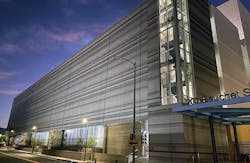Hyperconnected Data Centers: Optimizing Hybrid Cloud
Maile Kaiser, SVP of Sales & Business Development for CoreSite, highlights the emergence of the data-driven enterprise and how it has given rise to multi-cloud environments and hyperconnected data centers.
Maile Kaiser, SVP of Sales & Business Development for CoreSite
Current estimates suggest that the world produces as much as 2.5 quintillion bytes of data every day, a figure sure to add several more zeroes to its end as nearly 20 billion connected devices come online over the next year. It’s an understatement to say that data is abundant; what’s not understated, however, is the challenges that this incredible amount of data creates for the businesses trying to use it to their advantage.
As more organizations push toward digital transformation initiatives, they’re quickly understanding the importance of supporting real-time, instantaneous digital services as a competive imperative. The emergence of cloud technologies — especially of hybrid cloud environments — has given rise to the data-driven enterprise and the need for increasing both their ability to execute digital transactions at the edge and bring core processes physically closer to the end user.
But as many are finding out, yesterday’s infrastructure wasn’t built to support today’s business demands. Digital services produce an enormous amount of data, and organizations need a way and a place to collect, store and operationalize. They need a central meeting point for securely and efficiently exchanging data among various apps, services and clouds to realize their full business potential.
Business leaders face mounting pressure each day to better support the rapidly changing needs of their business and future-proof it to protect against getting left behind. In response, many are increasingly turning to hyper-connected data centers at the edge, strategically located to enable easy, low-latency data and content exchange to get the scale, speed and security they need to win.
Traditional data centers lack power and scale
The average enterprise uses over 1,400 distinct cloud services, including over 75 file sharing applications. Companies across industries, verticals and markets are producing and consuming more data than at any time in history. But almost three-quarters of it goes unused, because organizations are struggling to find ways of reliably, safely and cost-effectively storing it, transporting it and optimizing their infrastructure to best leverage it.
And while moving increasingly more data and workloads to the cloud to ease the physical space burden of conventional data center facilities seems to be the best solution, transporting massive volumes of data securely and reliably from on-prem data centers to cloud storage is neither cheap nor fast. Not only does moving data sequentially from Point A to Point B eventually to Point C dramatically increase the risk of security concerns, but the slower transmission also promotes data decay and service degradation. Entire industries are predicated on real-time connectivity and almost-instant transfer of the most recent and cleanest data:
- Autonomous vehicles need it for safe driving protocols, picking up data from the environment and acting on it instantaneously;
- Financial services firms use resource-intensive AI and machine learning solutions that require ingesting gargantuan volumes of data to automate personal finance decisions and root out fraud;
- Content delivery services need it to deliver HD-quality streams and eye-popping CGI in movies and TV shows; and
- Biotech firms need instant connectivity to support the enormous data sets needed to map genomes for life-saving medical breakthroughs.
So where might an organization with on-prem infrastructure that needs public cloud services turn to get the scale, speed and security they need?
Hyperconnected Data Centers Support Hybrid Cloud Strategies
Connectivity is crucial for supporting the widespread shift to microservices and distributed workloads driving most industries. Colocation at the edge is what enables that shift through seamless data exchange within the data center to connect networks, clouds and enterprises from within a single facility. And it’s giving rise to an increased need for a refreshed data center strategy favoring hyperconnected data centers.
Hyperconnected data centers feature all the characteristics digitally-enabled businesses require:
- Sufficient power density to scale on-premise physical infrastructure without additional floor space;
- Completely interconnected edge market locations for closer proximity to users; and
- Direct cloud on-ramps for easy, reliable access to additional storage and compute capacity.
This new breed of data center is specifically designed with efficiency, scale and connectivity in mind. It’s primary aim is to serve as the central meeting place — complete with physical infrastructure and comprehenisive interconnection options — for efficiently exchanging traffic and data among various network and cloud providers in strategic locations with closer physical proximity to end users.
Companies can create dedicated connections with partners and providers within the same location instead of connecting over a network outside the data center or over public Internet to dramatically reduce latency and improve performance. This is especially important for latency-dependent services and for supporting effective BCDR strategies. The enhanced connectivity is also crucial for achieving global physical and virtual connectivity that can extend a brand’s reach to, say, Asia or Europe. It allows organizations to tap into infrastructure half a world away without having to build out their own facilities in those regions.
Connectivity is crucial for supporting the widespread shift to microservices and distributed workloads driving most industries.
Today’s digital-first global economy is fundamentally reshaping the way enterprises plan and manage their business pursuits. Yesterday’s data centers are no longer sufficient for supporting the demands of the modern enterprise. They need faster service, greater scale and stronger security — all at lower costs. And they need hyperconnected facilities to achieve it.
Maile Kaiser is the SVP of Sales & Business Development for CoreSite in Los Angeles.

